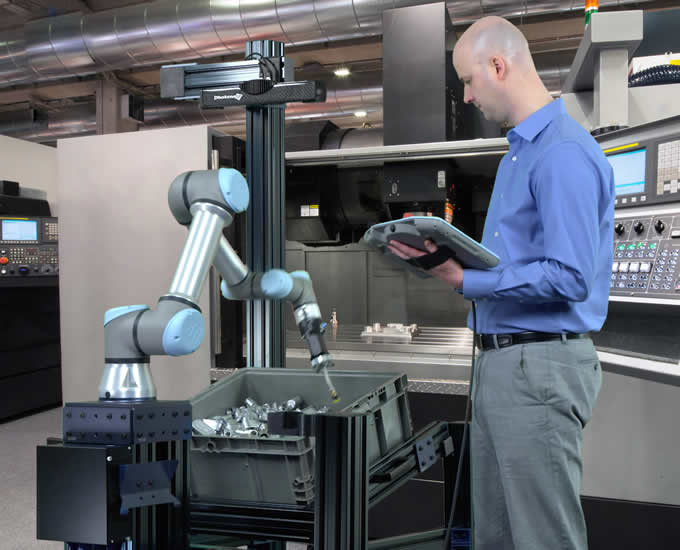Universal Robots Launches ActiNav, the World’s First Autonomous Bin Picking Kit for Machine Tending Applications

The complexity of automated bin picking is well-known throughout the industry, requiring huge efforts in both integration and programming. Today, most bin picking products are solely focused on the vision aspect of bin picking and often require hundreds of lines of additional programming to bridge the gap from “pick” to “place” – especially if the “place” is not just dropping into a box or tote but accurately inserting the part into a fixture for further processing. ActiNav Autonomous Bin Picking changes all that, allowing manufacturers with limited or no bin picking deployment expertise to quickly achieve high machine uptime and accurate part placement with few operator interventions.
ActiNav combines real-time autonomous motion control, collaborative robotics, vision and sensor systems in one easy to use, fast to deploy and cost-effective kit. The system requires no vision or robotic programming expertise, but is instead based on a “teach-by-demonstration” principle using a six-step, wizard-guided setup process integrated into the UR cobot teach pendant. ActiNav can be easily and quickly deployed by manufacturers’ in-house automation teams or through assistance from a UR distributor or integrator to deliver increased productivity, quality and efficiency.
“Machine tending has always been one of the mainstay applications for our collaborative robot arms,” says VP of Product and Applications Management at Universal Robots, Jim Lawton. “We discovered a significant market need for a simple solution that enables UR cobots to autonomously locate and pick parts out of deep bins and place them precisely into a machine. This is not pick and drop; this is accurate pick and part-oriented placement.”
ActiNav is available through UR’s distribution channel and via the new UR+ Application Kits platform, an expansion of the cobot pioneer’s successful UR+ ecosystem of components certified to work seamlessly with UR cobots. Like other UR+ application kits, ActiNav is developed with in-depth application knowledge that eliminates the duplication of engineering efforts when deploying widely used applications. ActiNav works with UR’s UR5e and UR10e e-Series cobots, a UR+ component or user-defined end effector, and application-specific frame or fixture as needed. The kit includes the Autonomous Motion Module (AMM) and ActiNav URCap user interface software, along with a choice of 3D sensors.
While there is a variety of approaches to automating machine tending stations, many of which include implementing trays, bowl feeders or conveyors to get the parts to the machine, Lawton explains how ActiNav bypasses this step. “Parts are often already in bins, so the most flexible and scalable option is to deliver that bin of parts to the machine and then pick them directly from the bin and place them into the machine,” he says. “This minimizes floor space and reduces the need for part-specific tooling.”
ActiNav autonomously inserts parts into CNC or processing machines such as drilling, deburring, welding, trimming or tapping. The high-resolution 3D sensor and CAD matching enables high-accuracy picks powered by ActiNav’s Autonomous Motion Module (AMM) that determines how to pick the part, then controls the robot to pick the part and place it in a fixture each time. The autonomous motion control enables ActiNav to operate inside deep bins that hold more parts; something that standalone bin picking vision systems struggle to accomplish.
IDC’s Research Director covering robotics, Remy Glaisner, is closely following the market for automated machine tending solutions. “Today more than ever, technology users are looking to preserve the integrity and continuity of business operations,” he says. “In that context, simplifying the integration or redeployment of highly flexible robotic systems becomes a critical capability for manufacturers and other industrial users. In many ways, ActiNav will set a new level of operational expectations regarding the future of intelligent systems.”
About Universal Robots
Universal Robots (UR) was founded in 2005 to make robot technology accessible to all by developing small, user-friendly, reasonably priced, flexible collaborative robots (cobots) that are safe to work side by side with people. Since the first cobot was launched in 2008, the company has experienced considerable growth with the user-friendly cobot now sold worldwide. The company, which is a part of Teradyne Inc., is headquartered in Odense, Denmark, and has regional offices in the United States, Germany, France, Spain, Italy, UK, Czech Republic, Poland, Hungary, Romania, Russia, Turkey, China, India, Singapore, Japan, South Korea, Taiwan and Mexico. In 2019, Universal Robots had a revenue of USD 248 million. For more information, please visit www.universal-robots.com.
Comments (0)
This post does not have any comments. Be the first to leave a comment below.
Featured Product

